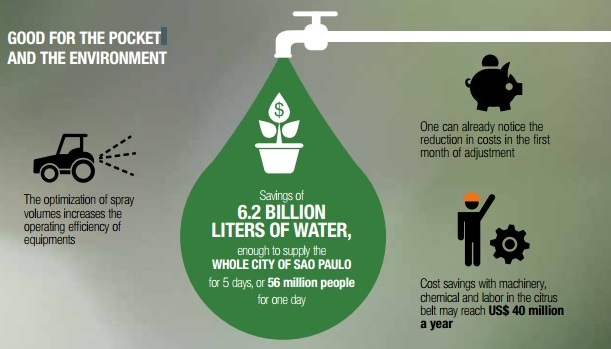2
fev
Efficient, cost-effective spraying categories: agrochemicals, Environment, Fundecitrus, Research, sanitary control, Sustainability, technology, Water

A research by Fundecitrus shows that it is possible to reduce the spray volume by 70%, and costs by up to 40% while maintaining quality of control deseases.
During the 2012-2013 and 2013- 2014 seasons, the researchers assessed several volumes of spray and copper rates to control citrus canker on trees of sweet orange “Valencia” planted in 2006, with an average canopy volume of 49 m³. Spray volumes were defined based on the tree canopy size, aiming to reduce waste of resources and production costs.
Volumes of 150, 100, 70, and 40 mL of spray mixture/m³ of canopy were tested during two seasons. The last two volumes were also assessed with adjustment of the copper rate. The study assessed the incidence of leaves and fruits with symptoms, premature fruit drop, yield, copper deposits on the leaves, spray coverage and the cost-benefit ratio.
In the first year, the copper-treated plants – regardless of the volume and copper adjustment – showed at the most 5% of occurrence of diseased leaves. Whereas non-sprayed trees showed a peak of 30% of leaves with citrus canker.
In the second year, results were similar to those in the first year, except for the 40 mL/m³ volume with no rate adjustment, which reached 10% of symptomatic leaves, between November and January, when tree flushing coincides with the occurrence of rains.
According to researchers, the lower protection of that treatment was caused by the reduction of product deposits on the tree. In this case, when the rate was adjusted, control was reestablished, showing that the 40 mL volume may be efficient, since the metallic copper rate is adjusted.
“The results show that spray volumes may be safely used by citrus growers. Lower spray volumes and copper rates may affect such control and are still being studied.”, affirms researcher Franklin Behlau.
With this method, citrus growers would save US$ 1.5 in one application, on a 100-hectare area, for example.
Equipment adjustments are required to use reduced volumes of spray, among which the use of spray nozzles that produce fine droplets (150 µm). The sprayer speed must not exceed 5.5 km/h, with a minimum coverage of 30% on the leaves inside the canopy.
According to Fundecitrus researcher Marcelo da Silva Scapin: “The adequacy of application volumes allows savings and reduction of the environmental impact, in addition to increasing the operating efficiency of the equipment”, he affirms.
As an example, if the reduction proposed by the research were applied to the Sao Paulo State citrus belt, which is currently estimated at 462 thousand hectares, if carrying out six applications per crop year, there would be savings of 6.2 billion liters of water, enough to supply the whole city of Sao Paulo for 5 days, or the equivalent to 56 million people for one day. The cost reduction for the whole citrus belt would reach US$ 40 million a year in expenses with equipment, product and labor.
To see the entire publication, please click here.
- |
